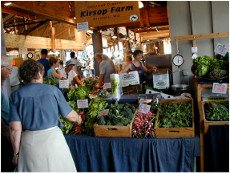MAY 2014
SMART SHOPPER’S GUIDE TO FARMERS MARKET

2. Develop a carrying strategy. By shopping farmers markets, you’re already improving your eating and shopping habits. Keep that momentum going and do your part to improve the environment and save your farmers some money at the same time – bring your own bags. If investing in reusable totes, you might want to consider the sturdy, flat-bottomed variety for produce and an insulated tote or small cooler for perishable goods. Also, farmers markets don’t usually have carts, but strollers make an excellent substitute. Don’t have a stroller? Check your local thrift shops for inexpensive options.
3. Bring small bills, score big rewards. Farmers markets and vendors vary when it comes to the types of payments they will accept. Bringing along small-denomination bills ensures that vendors are paid quickly and that the purchasing process goes smoothly no matter which vendor you’re shopping with. Your reward, this one little gesture will undoubtedly create good will with vendors.
4. Peruse first, purchase last. While every farmers market is different, they all use a fair-like booth setup. When you arrive, take your time and take everything in. Stand at the front and look around, taking stock of the setup. As you make your way around to each vendor, hold off on making a purchase. Instead, take mental notes of things like prices, quality and variety of options. Once you’ve browsed them all and asked any questions you might have you’ll be able to make educated choices about who to purchase from.
5. Know what you’re looking for and how to find it. Market guidelines that govern what is allowed to be sold vary greatly. Some markets permit only vendors who offer goods they’ve produced or grown themselves, while others might allow vendors to sell commercially purchased products and/or foods. If you’re unsure about whether a vendor’s wares are local or handmade, ask them. Also, when looking for organic produce, it is important to note that the organic certification process is costly and small farms may follow organic farming principles but not be able to afford the certification process. Be sure to always ask vendors about their farming philosophy and practices. Visit the Environmental Working Group for a quick list of fruits and veggies to buy organic.
6. Be a student of nature and health. Keep a notebook and take notes, during both your preparation and while at the market. Crops and growing and harvesting seasons vary by region. In the long run, you will benefit from writing down the dates when you see your favorite ingredients first being sold. This will help you familiarize yourself with the natural cycle of food availability in your area. Incorporate notes from at home taste tests and notes about different vendors. Find out where they sell their products and when. Ask about their growing philosophy and practices. And make a note of where their farm is located, so if ever they don’t have something or aren’t available, you can look for another vendor from the same area, which could provide similar tasting products.
7. Get to know your farmers as people. Think of them as your favorite neighbor. Introduce yourself and learn their names as well as the name of their farm and business. When the booths aren’t busy, take a couple of minutes to stop and chat. It doesn’t matter what you talk about, just make a point of socially interacting with the people who feed your family. This will communicate your appreciation, but go ahead and thank them while you’re at it. Respect goes a long way at the farmers market.
8. Conduct your own at home taste test. Nutritional and culinary qualities of foods vary based on a variety of factors including farming/raising techniques, geography and even handling methods. Conducting your own taste test of available foods is an excellent way to learn more about the foods and to figure out which vendors tend to produce your favorites. You’ll want to purchase several of the same items from different vendors. Be sure to note the vendor’s name, the price you paid and any other notes, such as the quantity and quality of the selection, the latter of which you’ll learn more about as you taste the bounty.
In response to consumers’ growing distrust in food sourcing, the Department of Agriculture launched the Know Your Farmer Know Your Food Compass, an online tool aimed at promoting relationships between consumers and their food sources. The Compass map shows USDA and other federally-supported projects that are fueling local food systems nationwide.
References
Photo Credit. FreeImages.com.
Local Harvest.
The Pros Reveal: How to Shop at the Farmers’ Market. iVillage.com.
The Crisper Whisperer: Ten Tips to Take to the Farmers’ Market. Serious Eats
TOMATOES
Native to the western regions of South America, but first cultivated in Mexico, it wasn’t until the 1500’s that Spanish explorers introduced tomatoes to European populations, and even then, they were often seen as unfit to eat. Today tomatoes are enjoyed worldwide at roughly 130 million tons per year. Botanically speaking, the tomato is both fruit and berry, but culinarily speaking, tomatoes are vegetables due to their cooking methods. The tomato comes in hundreds of varieties that vary in shape, size and color. Although nutrient levels will vary among varieties, tomatoes in general are widely known for their antioxidant content, including their rich concentration of lycopene. Tomatoes have been linked to heart health, bone health and even to lessening the risk of some cancers, including prostate cancer and possibly breast cancer. Research also has shown that tomatoes may help to lower cholesterol and possibly reduce the risk of neurological diseases, such as Alzheimer’s disease.

References
Photo credit. FreeImages.com.
Tomatoes. World’s Healthiest Foods.
Marz, Russell B. 1999. Medical Nutrition From Marz: A Textbook In Clinical Nutrition. Portland, Oregon: Omni-Press.
Gaby, Alan. 2011. Nutritional Medicine. Concord, N.H: Fritz Perlberg Publishing.
RECIPE: SALSA
Adding more vitamin-rich vegetables to your diet this summer is easier than you may imagine. This quick and easy salsa can be served for Cinco de Mayo, along with GMO-free tortilla chips for a healthy and festive addition to your Memorial Day cookout, and as a topping for grilled lean meats throughout the rest of the summer. This recipe will make about two cups, perfect for summer get-togethers.
- 4 – 6 ripe plum tomatoes, chopped
- ½ cup chopped onion (red or white)
- 1 jalapeno chili, stemmed, seeded and finely chopped
- ½ cup chopped fresh cilantro
- 2 tablespoons fresh lime juice
- ½ teaspoon salt or to taste
- ½ teaspoon fresh black pepper or to taste

References
Photo Credit. Isabell at Home.
LYCOPENE
Lycopene is a carotenoid pigment that gives fruits like tomatoes, watermelon, pink grapefruit and guava their red color. Unlike some common carotenoids, lycopene cannot be converted to vitamin A, but many of the foods that contain a good source of lycopene do in fact contain vitamin A outright, providing additional health benefits. Diets high in carotenoid-rich fruits and vegetables are often associated with reduced risk of cardiovascular disease and some cancers. Some studies have found that high lycopene intake lowers the risk of developing aggressive forms of prostate cancer in men.

Make your own tomato paste:
- Sauté a couple cloves of chopped garlic and 1 or 2 large onions, chopped, for a couple of minutes until they are translucent.
- Add 8 to 10 tomatoes, peeled and pureed, along with several teaspoons of fresh, chopped–or a teaspoon of dried–oregano, basil and any other herbs you enjoy, such as parsley or rosemary.
- Simmer for 30 to 45 minutes, or until thick. Then remove the mixture from the heat, drizzle with olive oil and add sea salt and freshly ground black pepper to taste.
References
Photo Credit. FreeImages.com.
Carotenoids: Alpha-Carotene, Beta-Carotene, Beta-Cryptoxanthin, Lycopene, Lutein, and ZeaxanthinTomatoes. World’s Healthiest Foods.
Marz, Russell B. 1999. Medical Nutrition From Marz: A Textbook In Clinical Nutrition. Portland, Oregon: Omni-Press.
Gaby, Alan. 2011. Nutritional medicine. Concord, N.H: Fritz Perlberg Publishing.
BASIL (Ocimum basilicum)

References
Photo Credit. FreeImages.com
Basil. Worlds Healthiest Foods.
Marz, Russell B. 1999. Medical Nutrition From Marz: A Textbook In Clinical Nutrition. Portland, Oregon: Omni-Press.
Gaby, Alan. 2011. Nutritional Medicine. Concord, N.H: Fritz Perlberg Publishing.
GARDENING THERAPY

- The American Horticultural Therapy Association’s characteristics of therapeutic gardens.
- The American Society of Landscape Architects website.
- Healthcare and Therapeutic Design Professional Practice Network’s Therapeutic Landscapes Network.
References
Photo Credit. Annies Gardens.
Gardeners Hand Care Routine. Garden Therapy.ca.
About Horticultural Therapy. American Horticultural Therapy Association.
Can Gardening Help Troubled Minds Heal? The Salt. National Public Radio.
Characteristics of Therapeutic Gardens. The American Horticultural Therapy Association.
American Society of Landscape Architects
Therapeutic Landscapes Network. Healthcare and Therapeutic Design Professional Practice Network.
The information offered by this newsletter is presented for educational purposes. Nothing contained within should be construed as nor is intended to be used for medical diagnosis or treatment. This information should not be used in place of the advice of your physician or other qualified health care provider. Always consult with your physician or other qualified health care provider before embarking on a new treatment, diet or fitness program. You should never disregard medical advice or delay in seeking it because of any information contained within this newsletter.
Follow us on instagram
BLOG
Become an educated consumer with our Indigo Blogs and prevent dis-ease.
Our Doctors have been featured in:









